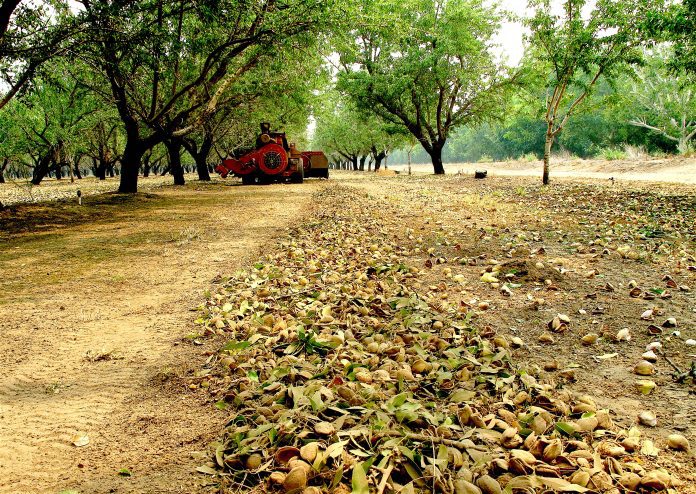UCCE Orchards Advisor Luke Milliron shared what he believes are the highest priorities for successfully growing almonds and walnuts during his North Valley Nut Conference presentation in January at the Silver Dollar Fairgrounds in Chico, Calif.
“What it really gets to, are you a risk-taker or are you risk-averse, that is what it really comes down to,” Milliron said.
His presentation covered four different subjects: almond/walnut rootstocks, walnut rootstock weaknesses, water and freeze.
“These are the things that have massive financial implications,” Milliron said.
He went on to add, “What we are talking about in difference here concerning what rootstock you plant can be a 1000- to 2000-pound difference in a single year. We are talking about hundreds of thousands of dollars of income in a short time span.”
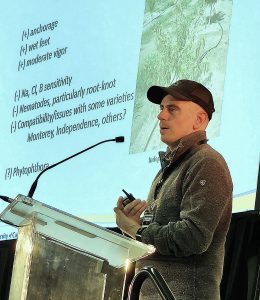
Rootstocks
Almonds
“As Roger Duncan, who’s done the most research at UC, will say, rootstock selection is by far the most important decision when planting; it is a lot more important than variety,” Milliron said.
He encouraged growers to not select by default or “to not make the decision on what rootstock to choose based on what their neighbors are planting.”
Milliron encouraged when making rootstock selection to make it site-specific, or based on the physical, chemical and biological conditions of the site.
His presentation focused for almonds on Krymsk 86 (K86)-peach x plum; Viking-peach, almond, plum, apricot complex; and peach x almond hyrids such as Hansen 536, Titan SG1 and Nickels.
“If you are a farmer in the north state, anchorage and wet feet are the two highest priorities for most of our almond farmers,” Milliron said.
He noted with anchorage, K86 has become the default go-to due to its “incredible” anchorage capabilities, with Viking coming in close second.
However, with K86, he cautioned that while it is good for anchorage, wet feet and moderate vigor, it has problems with salinity, nematodes (particularly root-knot) and compatibility issues with some varieties such as Monterey, Independence and a few others.
“As for phytophthora, it isn’t great, but at this point when it comes to phytophthora, we don’t have a lot of great options,” Milliron said.
He advised growers to check for rot-knot nematodes at a site before planting K86 as it is the worst in susceptibility.
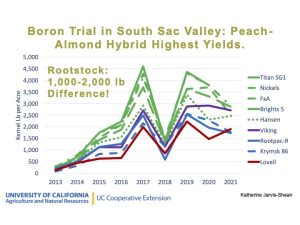
Referring to a boron trial by Katherine Jarvis-Shean, UCCE orchard systems advisor in the South Sacramento Valley, Milliron said peach-almond hybrid rootstock, such as Titan SG1 and Nickels, consistently had the highest yield; however, due to salinity, K86 and Lovell did very poorly.
“Viking is a rootstock I am very intrigued by,” Milliron added.
In anchorage it is second to K86, has moderate vigor, relative salt tolerance including boron (but not as good as the peach almond hybirds), does well under some nematode conditions, and does well in high-pH/alkali soil.
Viking’s yield compared to K86 is questionable. Some growers believe K86 provides a better yield.
It is somewhat susceptible to phytophthora and compared to K86 does have issues with wet feet.
“I like peach/almond hybrids, but we don’t plant a lot of them because we are so concerned about anchorage and wet feet, and maybe with wet feet we should be more concerned about phytophthora, and peach/almond hybrids are often the worst about phytophthora,” Milliron said.The hybrid is also weak in the areas of crown gall, lesion and ring nematode and bacterial canker.
However, Milliron explained, on the plus side, he has found this hybrid to be very vigorous and get much higher yields than many other rootstocks.Peach/almond hybrid is also salt tolerant including boron, resistant to root knot nematode and does well in high-pH/alkali soil.
“You can’t ignore those results,” Milliron said.
In a Nickels Soil Lab trial, 25th leaf trees with peach/almond hybrids and Viking rootstocks “held value the longest.”
Research conducted by Franz Niederholzer, Ph.D., UCCE orchard systems advisor, has shown plum and rootstocks with plum, such as K86 and Rootpac-R, can have compatibility issues with some varieties, namely Monterey to some extent and definitely Independence.
Quoting Bill Burchell, Milliron said, “It takes 20 years to prove a variety. And I would add rootstock and new rootstock/variety combos to that.”
He added, if a grower is risk-averse, plant next what’s been most profitable for you over the past 20-plus years.
“What is giving you the most profit on a year-in-year-out basis, maybe just stick with that as there is risk to planting something that doesn’t have that 20-year track record,” Milliron explained. “I would much rather do the trial for you and being the researcher and finding out that something is problematic.”
He talked about the current almond variety trial at the California State University, Chico farm.
“In addition to what we currently have, we will be planting this winter another 30 new varieties to start testing,” he said.
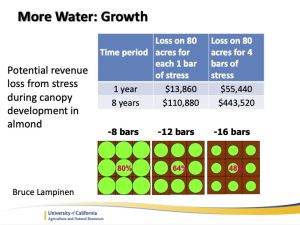
Walnuts
Right out the gate when talking about walnut rootstocks, Milliron said, “Please, don’t plant Paradox seedling. It is so susceptible to phytophthora and crown gall. I would really point toward the new clonals as the way to go.”
When selecting a rootstock, he suggests first looking at the problems that may arise, such as blackline, phytophthora, nematodes and crown gall.
The problem/rootstock:
- Blackline: own-rooted English
- Phytophthora: RX1
- Nematodes: VX211
- Crown gall: RX1, Black
- Salinity: Black as a possibility
For potential planting sites with oak root fungus, Milliron suggests focusing on other problems. “For waterlogging, we just don’t have anything yet,” he said. “For most situations, I would plant RX1 or VX211. Both have good vigor and less crown gall.”
Although there is little data currently on the Grizzly variety, Milliron finds it to be “very promising.”
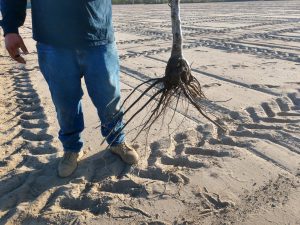
Water Trials
Milliron encouraged growers to use county Resource Conservation District Mobile Irrigation labs.
“Free system evaluations are available through several counties,” he explained. For help contact:
Tehama, Shasta, Butte, Glenn counties: Kevin Greer, 530-727-1297 or kevin@tehamacountyrcd.org.
Yolo County: Conor Higgins, higgins@yolorcd.org
Solano County: Kevin Young-Lai, kevin.young-lai@solanorcd.org
Sutter-Yuba-Colusa counties: Karandave Kang, karandeavek@gmail.com
“If you have your water spraying every which way, then none of the rest of your efforts matter at all. And when you try to do cross protection, you will really be in trouble,” Milliron added.
Another focus was pressure chambers.
“I am a big proponent,” he said. “Water status has huge growth, yield and tree health consequences. I think asking the tree what it is experiencing in terms of water, there is no substitute for doing that.”
Milliron referred to a water trial by Integrated Orchard Systems Specialist Bruce Lampinen and said at the end of the eight-year trial, trees at 16 bars hadn’t filled half the space versus trees at 8 bars were at maturity.
“What that means is for an 80-acre orchard, just 4 bars of stress can have a difference that equals out to $443,520 loss to the grower,” he said.
Walnut: Irrigate at 2 or 3 bars drier than the fully watered baseline.
Almond: Irrigate at 2 to 4 bars drier.
Milliron went on to explain, however, more water isn’t always better. “For instance, you give a walnut tree a little too much water and you get a canopy that just starts collapsing in on you.”
In addition, too much water is just asking for phytophthora, which moves with water. “Watch your irrigation set length. Avoid ponding and keep water off the trucks,” he emphasized.
To help avoid water problems, Milliron reminded growers of cultural management in the orchard (use stream-splitters, avoid sprinklers contacting low scaffold and plant on berms) with the question, “Can soil infiltration be improved with amendments or cover crops?”
Check soil moisture and distribution uniformity and pay attention to the beginning and end of the season were his final remarks on water.
“Don’t water until the tree tells you it needs it. In the spring, you will see your neighbors already watering, but if your trees say they don’t need it yet, wait until they do,” Milliron said.
Freeze
Milliron shared six steps to prepare for sudden autumn freeze:
August: Fertilizer cut-off.
September: For young trees, withhold irrigation until terminal bud sets.
If rains haven’t come, irrigate going into November.
October to December and April: Monitor soil moisture and weather.
If a freeze is predicted and soil is dry, it should be wetted two to three days prior.
If a grower has the capability, consider active frost protection with solid-set irrigation.
If a grower does suspect damage, Milliron advised to cut into the branches as soon as possible and check for drying or browning.
If damage does occur, paint the southwest side of the damaged trees with 50% diluted (1:1 water to paint) white interior latex paint.
If trees don’t leaf out in April as expected, look back at temperature records. “Was there a sudden autumn freeze?” Milliron asked.
Don’t overreact. Wait, Milliron stressed.
“Provide water starting in May, nutrition, treat for sunburn and wait to prune,” he said. “You will often see delayed leaf out on blank wood. Do start pruning by summer and cutting out the dead wood and, if at all possible, burn it to avoid Bot or Phomopsis.”
He invited those attending the conference to listen to the podcast “Growing the Valley” created by Milliron and Dr. Phoebe Gordon, farm advisor in Madera, produced through UCCE and available on its website, growingthevalleypodcast.com.


